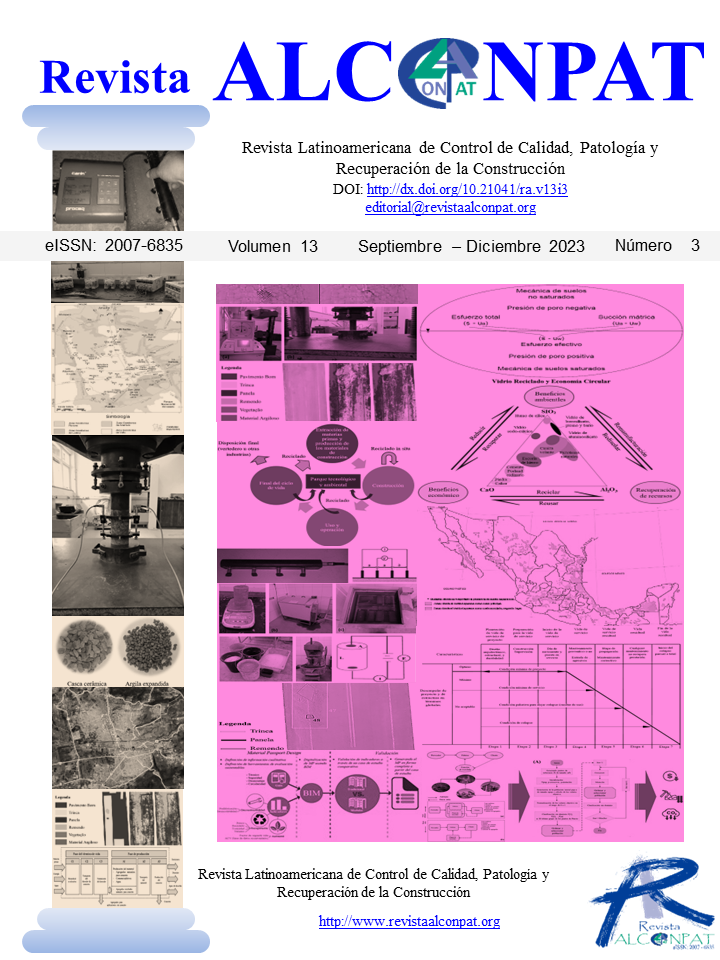Resistivity thresholds to evaluate durability of concrete with waterproofing agents and different water/cement ratios
Abstract
In the present work it is evaluated how the variation of the water/cement ratio influences the electrical
resistivity of the concrete; the type of cement selected (CPP and CPF); and the incorporation of a water
repellent. Cylindrical specimens were made on which the resistivity was evaluated using the Wenner
probe method. Comparing the results obtained with the threshold values indicated in the literature, it is
possible to understand the importance of this degradation mechanism that implies limiting the
maximum w/c ratio to 0.45. On the other hand, the CPP cement turned out to be the one with the best
performance, giving rise to higher resistivity results, while the incorporation of the water repellent had
a null or counterproductive effect on said parameter.
Keywords: durability; corrosion; Wenner probe; electrical resistivity
Downloads
References
Andrade, C., & D’andrea, R. (2011), La resistividad eléctrica como parámetro de control del hormigón y de su durabilidad. Revista de la Asociación Latinoamericana de Control de Calidad, Patología y Recuperación de la Construcción, 1(2), 93-101. https://www.redalyc.org/articulo.oa?id=427639585001
Andrade, C. (2018), Design and evaluation of service life through concrete electrical resistivity. Revista ALCONPAT, 8(3), 264-279. https://doi.org/10.21041/ra.v8i3.349
Associação Brasileira de Normas Técnicas. (1985). NBR 9204: Concreto endurecido - Determinacao da resistividade eletrica-volumetrica. Rio de Janeiro, Brazil.
Asociación Española de Normalización. (2008). UNE 83988-2: Durabilidad del hormigón. Métodos de ensayo. Determinación de la resistividad eléctrica. Parte 2: Método de las cuatro puntas. Madrid, España.
Broomfield, J., & Millard, S. (2002), Measuring concrete resistivity to assess corrosion rates. Concrete, 36(2).
Canin+ (2012), “Operating instructions, corrosion analyzing instrument”, PROCEQ, Suiz
Cavalier, P. G., Vassie, P. R., & TRRL. (1981), Investigation and repair of reinforcement corrosion in a bridge deck. Proceedings of the Institution of Civil Engineers, 70(3), 461-480. https://doi.org/10.1680/iicep.1981.1784
Dal Molin D. (1988), “Fissuras en estructuras de concreto armado: Análisis das manisfetacoes típicas e levantamento de casos ocorridos no Estado do Rio Grande do Sul”, Universidad Federal de Rio Grande do Sul, Porto Alegre, Brasil.
D'Andrea, R. (2010), “Predicción de la durabilidad del hormigón armado a partir de indicadores de corrosión: aplicación de la resistividad eléctrica”, Doctoral Thesis, Caminos. https://doi.org/10.20868/UPM.thesis.3704.
Di Maio A., Sota J., Traversa L. (1999), “Patología de estructuras de hormigón. Análisis de algunos casos más relevantes ocurridos en la Argentina en los últimos años”, III Congreso Iberoamericano de Patología de la Construcción y V Congreso Iberoamericano de Control de Calidad, La Habana, Cuba.
DURAR (2008), “Manual de inspección, evaluación y diagnóstico de corrosión de estructuras de hormigón armado”, CYTED, Córdoba, Argentina.
Hope, B. B., Ip, A. K., & Manning, D. G. (1985), Corrosion and electrical impedance in concrete. Cement and concrete research, 15(3), 525-534. https://doi.org/10.1016/0008-8846(85)90127-9
Hornbostel, K., Larsen, C. K., & Geiker, M. R. (2013), Relationship between concrete resistivity and corrosion rate–A literature review. Cement and concrete composites, 39, 60-72.
https://doi.org/10.1016/j.cemconcomp.2013.03.019
Instituto Argentino de Normalización y Certificación. (2004). IRAM 1534: Hormigón. Preparación y curado de probetas en laboratorio para ensayos de compresión y de tracción por compresión diametral. Buenos Aires, Argentina, IRAM.
Instituto Argentino de Normalización y Certificación. (2000). IRAM 50000: Cemento para uso general. Buenos Aires, Argentina, IRAM
Irassar, E. (2001), “Durabilidad del hormigón estructural”, XIV Reunión Técnica de la Asociación Argentina de Tecnología del Hormigón y Seminario de Durabilidad del Hormigón Estructural, Olavarría, Buenos Aires, Argentina.
Koch, G. H., Brongers, M. P., Thompson, N. G., Virmani, Y. P., & Payer, J. H. (2002), Corrosion cost and preventive strategies in the United States (No. FHWA-RD-01-156, R315-01). United States. Federal Highway Administration.
https://rosap.ntl.bts.gov/view/dot/40697/dot_40697_DS1.pdf
Medeiros-Junior, R. A., & Lima, M. G. (2016), Electrical resistivity of unsaturated concrete using different types of cement. Construction and Building Materials, 107, 11-16. https://doi.org/10.1016/j.conbuildmat.2015.12.168
Morris W., Moreno E., Sagüés A. (1996), Practical evaluation of resistivity of concrete in test cylinders using a Wenner array probe, Cement and Concrete Research, 26, 1179-1787. https://doi.org/10.1016/S0008-8846(96)00175-5
Polder R., Andrade C., Elsener B., Vennesland O., Gulikers J., Weider, R., Raupach M. (2000), Test methods for on-site measurement of resistivity of concrete, RILEM TC 154-EMC: Electrochemical techniques for measuring metallic corrosion, Materials and Structure, Vol 33, 603- 611. https://doi.org/10.1016/S0950-0618(00)00061-1
Reglamento Argentino de Estructuras de Hormigón (2005). CIRSOC 201. INTI-CIRSOC.
RILEM TC-154-EMC. (2000), Electrochemical techniques for measuring corrosion in concrete, Materials and Structures, Vol. 33, 603-611. https://www.rilem.net/groupe/154-emcelectrochemical-techniques-for-measuring-metallic-corrosion-in-concrete-154
Smith, K. M., Schokker, A. J., & Tikalsky, P. J. (2004), Performance of supplementary cementitious materials in concrete resistivity and corrosion monitoring evaluations. Materials Journal, 101(5), 385-390. https://doi.org/10.14359/13424
Van Noort, R., Hunger, M., & Spiesz, P. (2016), Long-term chloride migration coefficient in slag cement-based concrete and resistivity as an alternative test method. Construction and Building Materials, 115, 746-759. https://doi.org/10.1016/j.conbuildmat.2016.04.054
Wallbank, E. J. (1989). The performance of concrete in bridges. A survey of 200 highway bridges. https://worldcat.org/es/title/59085774
_______________________________
License in effect from September 2020
You are free to:
- Share — copy and redistribute the material in any medium or format for any purpose, even commercially.
- Adapt — remix, transform, and build upon the material for any purpose, even commercially.
- The licensor cannot revoke these freedoms as long as you follow the license terms.
Under the following terms:
- Attribution — You must give appropriate credit , provide a link to the license, and indicate if changes were made . You may do so in any reasonable manner, but not in any way that suggests the licensor endorses you or your use.
- No additional restrictions — You may not apply legal terms or technological measures that legally restrict others from doing anything the license permits.
Notices:
You do not have to comply with the license for elements of the material in the public domain or where your use is permitted by an applicable exception or limitation .
No warranties are given. The license may not give you all of the permissions necessary for your intended use. For example, other rights such as publicity, privacy, or moral rights may limit how you use the material.





















.png)














